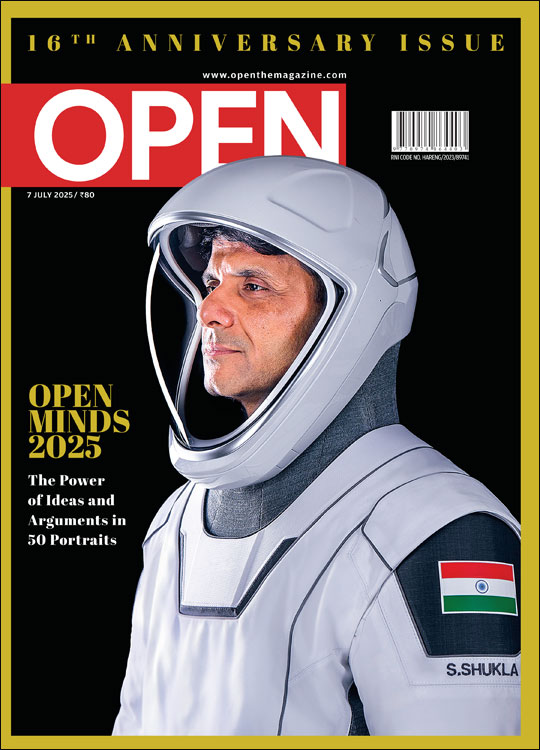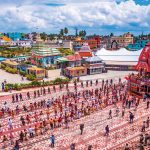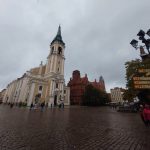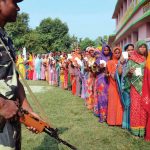A Movement Revisited
The independence struggle as a narrative of the highs and lows of our national will
 Ram Madhav
Ram Madhav
 Ram Madhav
Ram Madhav
 |
10 Aug, 2017
|
10 Aug, 2017
/wp-content/uploads/2017/08/Lucknow-Pact-1916.jpg)
The revisiting of history keeps happening. There are a couple of reasons why one revisits history time and again. One reason, of course, is that we get newer information as time passes. When we chance upon a new document or discovery, we have to reinterpret a few things in its light. But there is another important reason, and that is to draw contemporary lessons for the present and the future.
We have to return to history from multiple angles. Napoleon had said, “What is history, after all? It is a fable mutually agreed upon.” History is what the rulers and the ruled agree upon; that is how it is written. Somebody sees the past from a perspective and that is validated by the rulers, scholars or leaders of the time. That becomes history. That is why attempts to reinterpret history from varying perspectives with changing times should keep being made.
That does not mean one can play with facts. After all, history is essentially the interpretation of certain facts. It is prone to interpretations. This process involves biases, and, depending on the interpreter, the same fact is presented in varied ways. It is therefore hard to say if ‘unbiased history’ exists.
But history does not have any scope for ifs and buts. This must be kept in mind while interpreting it. Conjecture—such as ‘Had Gandhi not existed, what might have happened?’—is not history. Arguments about the actions of individuals that go ‘Had he not done this’, etcetera, are mere imagination.
Then why revisit history? To what purpose? Jawaharlal Nehru used to say, “Those who forget history are condemned to repeat it.” Every time we go back to it, we should draw some contemporary lessons from it.
Did our independence movement have a wider canvas? Did it have multiple main and fringe players? It had four or five prominent streams. Tribals, writers and literary figures et al had their own movements. Similarly, there were struggles led by saints and revolutionaries. The mainstream movement for freedom was led by the Congress, but that too had various streams. It was just a platform and never a homogenous unit. Right from the beginning, it had a division between moderates and hardliners. Many streams merged with the Congress in order to achieve the common objective of self-rule. Every stream was no less important.
Consider this interpretation. Clement Attlee, when he became the prime minister of Great Britain, had decided to give independence to India. Churchill was staunchly opposed to this idea; he believed it would result in anarchy in India. To his mind, Indians were incapable of self rule. Attlee, on his part, gave three reasons for India is to be given freedom. The first was that in World War II, Britain had suffered huge losses and didn’t have enough resources to manage its own country. Its condition was best captured by the statement, ‘It won the war but lost the empire.’ Second, there were protests across India against the Red Fort trials of Azad Hind Fauj members, who had even crept into the armed forces to a point that Sardar Patel had to be brought in to intervene (this included the naval mutiny in Mumbai, an army base in Jabalpur and air force base in Rajasthan). Third, the 2.5 million strong Indian army was too big to be controlled by British forces with only 40,000 soldiers stationed in India at that time. World War II had drained all their energy and they did not want to fight another battle.
Now these reasons given by Attlee are open to interpretation. Someone can say that while talking about them, he did not even mention Gandhi. There was a judge based in Kolkata who claimed that Attlee had visited him in 1956 at his residence, and he asked him why he didn’t mention the contributions of Gandhi and the Congress as a reason to grant India freedom. Did they have no role worth mentioning? According to that judge, Attlee twisted his lips and said, “minimal.” Was it really minimal? No. But that is the problem with interpretations. Therefore, when we revisit the movement, we should be careful not to jump to hasty conclusions but to learn lessons from each new fact and finding. What is it that we can learn from a revisit in contemporary times? One important lesson is what John Kenneth Galbraith had said in an interview in 2001: “The progress of India didn’t depend on the government, as important as it might be, but was enormously dependent on the initiative of the Indian people.” One leader who understood this was Gandhiji. It was he who had transformed the struggle into a popular movement. He understood that India’s strength lay not in leaders but in its people. For it to succeed, it had to have mass support.
In initial years, the Congress was an elitist movement. One of its founders was AO Hume, a British civil servant who came to India to perpetuate British rule here. Among other founders was Surendranath Banerjee, steeped in English education and culture. The first 15-20 years of Congress history was of petitions and applications. It was Gandhiji who transformed it into a mass movement. People from places far away from Delhi too were prompted to participate. They contributed to it in whichever manner they could.
But did our independence came through this popular movement led by Gandhiji alone? Suppose it did not take place, would Independence not have come? Was there a popular movement for Pakistan? This country was the outcome of a bargain. It had no mass movement. Whatever popular support there was for it came from areas that are now in India. Those who became citizens of Pakistan never fought for its creation. If you look at the 1946 election results to provincial assemblies in what is Pakistan today, the Muslim League lost in almost all those provinces. Jinnah’s party, the champion of the partition of India, could not secure an electoral mandate in those very parts which became Pakistan one year later.
There is a probability that the British would have been thrown out without any popular movement. They could have been forced out by other revolutionaries or by the Azad Hind Fauj’s armed rebellion. But Gandhiji believed that the struggle was for its people and not merely for a change of government. That’s the reason why when all the important leaders were celebrating independence in Delhi, he was away at Noakhali, among people who were suffering. He could have come for a day, participated in the celebrations, and then gone back. But his conviction was that governments in India will come and go but India is about its people.
Here Gandhiji was not alone. There were similar leaders and groups at the time. The RSS, from which I come, has been branded differently today. The RSS leadership believed right from its inception in 1925 that India needs independence, but as a product of a popular movement. That is why the organisation chose the mission of inculcating patriotism in ordinary Indians. All social reformers had the same belief that society needed to be prepared first for India to be an independent nation. Just a change of government was not what freedom meant to them. Unfortunately, such movements have not been accorded their due respect and place in history.
At the time of independence, we paid a heavy price in the form of partition. One-third of our motherland became foreign territory overnight. The Muslim League had passed its Pakistan Resolution in 1940 at its Lahore session. The reaction of the Indian leadership at that time is worth recounting. “Vivisect me before you vivisect India,” declaimed Gandhiji. Sardar Patel went one step further to declare: “Talwar se talwar bhidegi” (sword will clash with sword), meaning that India would fight till the end against partition. Dr Rajendra Prasad, who was in jail during the Quit India Movement, went on to write the book India Divided, in which he spoke of the ills of partition and how illogical the thought was. Even before the ink on that book could dry, India was partitioned. Nehru, in his typical romantic way, proclaimed that the idea of partition was “fantastic nonsense”, meaning ‘the idea of some mad people’. The tragedy is that it was the same Nehru who went on to sign the partition agreement, called the June 3rd Plan. Sardar Patel remained a mute spectator.
Not just Indian leaders, even British leaders had not wanted India to be partitioned initially. Viceroy Wavell famously declared his opposition to the idea in 1944, stating that, “India is a God-made triangle, you cannot divide it.” Even Atlee’s mandate as Britain’s prime minister to Mountbatten was not to partition India. ‘Keep it united if possible. Save a bit from the wreck. Bring the British out in any case’ was Attlee’s instructions to Mountbatten.
Almost nobody wanted partition. Still, it happened. There is a big lesson to learn from this; that nations can’t put all their faith in their leadership alone. A nation has to have its own innate strength.
Let us map the hundred-year journey of India from the First War of Independence in 1857, as Savarkar described it, to 1956. In 1857, leaders like Tatya Tope, Rani Laxmibai and Nanasaheb had launched a war to eject British rulers from India. The immediate provocation was the obduracy of the British in their imposition of certain unIndian cultural practices on the British Indian Army. Then came a revolutionary movement initiated by Vasudev Balwant Phalke in the 1880s, followed by the Congress movement, leading to independence in 1947.
In 1956, India’s then prime Minister Jawaharlal Nehru gave an interview to John Kenneth Galbraith in which he said: “You know, Galbraith, I am the last Englishman to rule this country.” So this journey which started with a resolve to throw out British rulers ended up with our own leaders who were more British than probably the British themselves. What did we really fight for? What was the battle all about? Was it just to replace people of one skin colour with another?
Independence meant freeing the spirit of quintessential Indianness. But we identified it with the leadership and not with the spirit. Gandhiji realised this, but it was too late. In 1946, when the Kolkata killings were going on after Jinnah’s call for Direct Action, Gandhiji was asked whether he would still stand by his statement of 1940: did he still think that partition could be prevented? Could Hindus and Muslims live together after all this mayhem? His response provided one of the greatest lessons of our independence movement. He said that his words in 1940 were a reflection of the popular sentiment of the time, but on seeing the madness all around he had realised that the young men of our country were not prepared to stand firm, go onto the streets and fight for the unity and integrity of this nation. Therefore, there was no option but to agree to partition. When the time came for shedding blood for the country’s unity, our countrymen were not prepared to pay that price. And the country was divided.
Let us go back in history by 40 years. The first attempt at partitioning the country on communal lines had happened in 1905. Bengal was split into Hindu and Muslim parts. There was nationwide opposition to this act of the British, led by the trio of Lal, Bal, Pal—Lala Lajpat Rai, Bal Gangadhar Tilak and Bipin Chandra Pal. The then Viceroy Curzon had pompously declared that the “partition of Bengal is a settled fact”. But the opposition to it grew so strong and loud that six years later King George V had to rush to India in 1911 and annul the state’s partition. The so-called ‘settled fact’ had been unsettled by the national will.
Why then did we become so helpless when in 1947, not one province, but the entire country was to be partitioned? This is an important facet of our history to revisit. Did we miss the spirit and identified the entire movement with some individual leaders? When those individuals became helpless, did the entire movement become equally so? We cannot afford to ignore this important question.
Our independence movement shows that whenever the national will was robust, we achieved success. There was a phase in our freedom movement, of roughly three decades between 1915 and 1947, when a lot of confusion had crept in. Several incidents during this period should be re-examined by scholars. It was during these decades that Jinnah, a follower of Tilak and a volunteer of Congress, went on to become the founder of Pakistan.
How did the independence movement become a bargain between different groups? This is a topic of research. A slogan was coined by Tilak at the Lucknow Session of the Congress in 1916: ‘Luck Now at Lucknow’. What was the luck in 1916 that Tilak was referring to? The Muslim League had come to participate in the Congress session. People started believing that without the League, there would be no independence. The Congress started negotiating with the party and when it agreed to attend the session, luck was said to have smiled. This is when the bargaining began.
Savarkar’s famous advice to Gandhiji regarding this was that he should tell the Muslim League categorically that ‘If you come, with you. If you do not, without you. If you oppose, in spite of you’. This is called the national will. But the history of 1916 to 1946 was just the opposite. I would urge young scholars to revisit this part of our history. Why did institutions like AITUC, created by the Congress, turn leftist organisations? How did the left and anarchist streams enter Congress? Where was the confusion created? Why were compromises made on issues like the national flag, anthem and language? How did Nehru become influenced by socialist ideology after his return from Moscow in 1927? What was the seriousness of differences between Gandhiji and Nehru and how much did they influence the outcome of our freedom movement?
These are some of the things to be studied. We cannot undo anything in history by doing so. But we can always learn lessons from it. Some of these might be unpalatable but we have to learn even those. This is important so that we do not repeat past mistakes. Interpretation of history has no end. There can be and will be many further interpretations. History should be analysed with openness.

/wp-content/uploads/2025/06/Cover-OpenMinds2025.jpg)











More Columns
Puri Marks Sixth Major Stampede of The Year Open
Under the sunlit skies, in the city of Copernicus Sabin Iqbal
EC uploads Bihar’s 2003 electoral roll to ease document submission Open